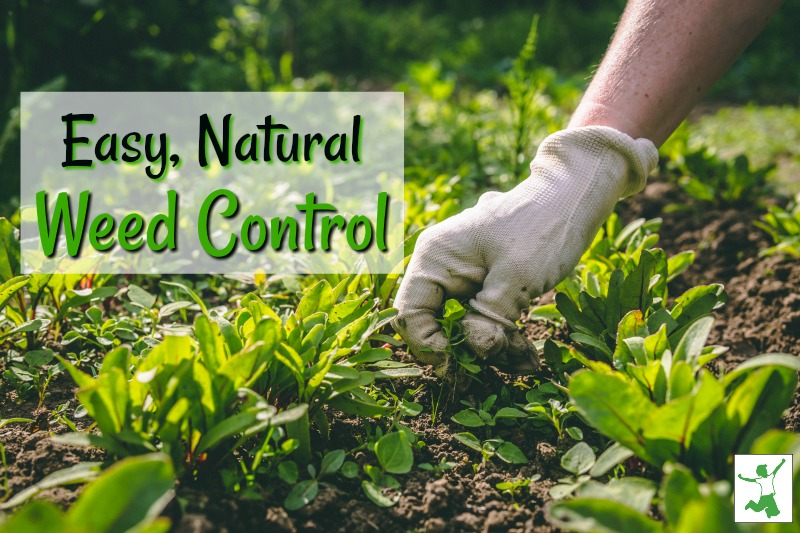Table of Contents[Hide][Show]
Easy and inexpensive methods to control weeds naturally in your landscaping beds and garden all growing season long to minimize the need for hand weeding.
Without a doubt, weeding is one of the most onerous tasks when it comes to the upkeep of gardens and landscaping around the home. Unfortunately, most people still seem to rely on chemical herbicides to do the job with Roundup and related products that contain gut flora destroying glyphosate as the active ingredient.
Fortunately, there are a number of natural weed control methods to employ once you realize the health dangers of using these types of products!
The easiest method that I regularly use for the cracks and crevices on the patio and driveway is a tea kettle full of boiling water.
A drizzle on each emerging weed and, poof! They shrivel up and disappear for several weeks if not a month or more.
But what about areas where you don’t want to harm existing plants like your vegetable garden or landscaping beds?
In those cases, using plant fibers to form a soil barrier for emerging weeds works great!
The trick is to use it after the desirable plants have already emerged from the soil and are otherwise established.
You also need to use plant fibers that contain a significant amount of protein as well.
Then, the plant fiber added to the soil will form a barrier that inhibits seeds from sprouting. This includes many of the most common forms of weeds.
As a preventative, this type of fiber prevents weeds from growing at all and thus, stops them from competing with your flowers, shrubs or veggies for water and nutrients. Not to mention they are unsightly!
Cornmeal Gluten to Inhibit Weeds
According to master gardener Susan Patterson, cornmeal gluten is the best plant fiber to use for this purpose.
Note that the term “cornmeal gluten” is a misnomer, since corn is 100% gluten-free! (1)
Cornmeal “gluten” is a by-product of the corn milling process. It is not edible. Corn gluten contains about 60 percent protein and 10 percent nitrogen, which also serves as a natural fertilizer.
Be sure to buy nonGMO products and even better, organic cornmeal gluten especially if this will be applied to your garden where edibles are growing! This is to ensure that no glyphosate residue heavily used on GMO crops ends up in your garden soil!
As long as the cornmeal is applied after desired plants are established and before annual weeds emerge, the method should be effective.
Weeds that are effectively inhibited by cornmeal include: (2)
- foxtail
- purslane
- pigweed
- crabgrass
Note that perennial weeds are unaffected by cornmeal gluten application because their roots survive in the soil over the winter.
Examples of weeds unaffected by cornmeal application include: (3)
- dandelions
- quack grass
- plantain
You’re still going to have to manually pull those, unfortunately.
Jute as Natural Weed Control
The downside of organic cornmeal gluten is that it is rather expensive.
You can get concentrated cornmeal gluten less expensively per application, but then you are dealing with a GMO product that almost certainly is laced with glyphosate residue. If you’re like me, you won’t want that stuff anywhere near your home especially any edible plants, shrubs, and trees.
How does free and safe sound to you as a better alternative?
As it turns out, cornmeal gluten isn’t the only product on the block that can inhibit weeds!
Jute fiber is about 52% protein (the rest is starch), nearly as high as cornmeal gluten. (4)
This is enough where it will work to inhibit weeds, especially if you are consistent in applying it periodically (every month or two) throughout the initial growing season and then, year after year.
The results are not dramatic at first. Best results occur with each consecutive year you apply it. In other words, you will observe better weed suppression the second year than you had in the first year, greater results in the third year than the second year, and so forth.

Naturally Low Spray and GMO-free
Known also as burlap, jute is a tall grass native to southeast Asia. It is GMO-free and not highly sprayed, hence, it would be a safe product to use in the garden.
Like cornmeal gluten, jute fiber acts as a mild fertilizer as it contains a fair amount of magnesium and phosphorous. (5)
So where do you get some for free?
A growing list of environmentally conscious companies use jute as biodegradable insulation and peanuts for shipping purposes. (6)
The video below shows the jute starch fiber insulation in a box of Bonafide Provisions broth and soups that shipped to my home recently.
Note that if you are going to use jute as a weed inhibitor for your landscaping or garden, it will take several watering applications or rainfall events to completely submerge into the soil. You can also mash or grind it up and then water into the soil for faster effect.
References
(1) Does Corn Contain Gluten?
(2, 3) Cornmeal in the Garden
(4, 5) Jute Nutritional Information
(6) Temperpak FAQ








I looked up and down the page several times and saw no video. Is there a broken link? Thank you.
It’s there … I just checked. If you are using an ad blocker, you won’t see it.